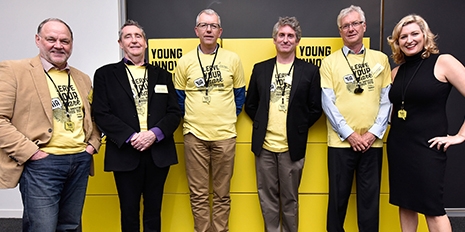
A rainy morning greeted us following the sixth annual awards ceremony for the Young Innovator Awards. Luckily, we were secure and dry inside, oblivious to the weather as we listened to the unique stories of six of New Zealand's legendary innovators. Each came with their stories of going from start up to success, from school to super star. This is the third year we've held the Innovation Forum and each time we come away enlightened and inspired by these speakers.
These legends of innovation each had their own take on what innovation meant to them, but one phrase from Jenene Crossan rang true through each of the stories: "Innovate or die" (and this should probably be the theme for next year…) Innovation was a key to success for many of the companies, whether it was a revolution of business practices, innovating solutions, or understanding the value that innovation brings to your audience.
We have collected our thoughts and takeaway points for each of the speakers, and we'd love to hear what you thought of this year's forum.
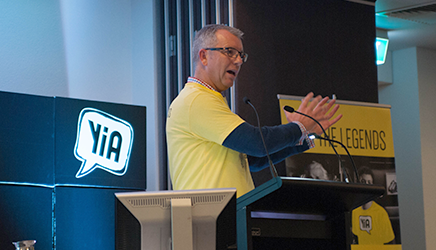
First up was local legend Peter Tinholt, General Manager Asia Pacific for Taura Natural Ingredients. He told an honest recount of Taura's history, starting right back in 1973.
The company started with "water, fruit, and a whole lot of sugar", as a basic foodstuffs company. Pretty quickly, they discovered that the 'low margin, high volume' approach wouldn't cut it. In order to get ahead in the market, they needed new products.
What I understood is that it was really a make or break situation. They had nothing to lose, because they had everything to lose. Doing nothing meant dying. From their experience with their caramel production plant they realized they could improve their processes and utilize more of the actual fruit and its by-products. And this led to the development of Ultra Rapid Concentration (URC).
URC technology allowed for endless possibilities for fruity foods. A sophisticated concentration process reduces fresh fruits to a dehydrate of 6-8% moisture, tailored to match the water content of the fruit concentrate to that of the food product and create delicious, long life products. From chocolate and muesli bars, to cereal and ice cream, the list of delicious applications for fruit goes on.
But innovation within Taura goes beyond new technology. Recognizing the importance of imagination, the team is given time to play, to explore crazy ideas and new products, without worrying about the free time counting against their KPI's. Peter stressed the importance of having fun and looking after your people to increase productivity and innovation.
Taura foods has also been very conscious about who they team up with. The right partnerships early on can mean the difference. For Taura, collaboration has led to a strong brand that supplies to any big food brand imaginable. With an ever changing food landscape with a lean towards banning sugar, Taura has been very focused on the end-consumer and the benefits of their natural fruit-based product.
Takeaway Points
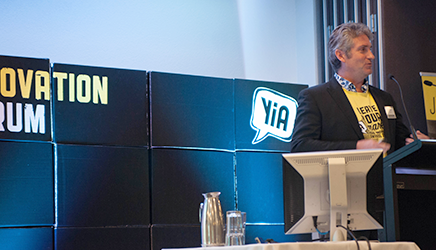
As a young boy, Wayne always wanted to know how things worked. He enjoyed taking things apart and putting them (mostly) back together, asking questions and constantly building and acquiring new skills. His parents even bought him a subscription to a science magazine, just to keep him busy! It is therefore not strange that he has walked a rather exotic career path.
After studying Civil Engineering he applied his learnings to wool research and fibre modelling - looking specifically at the difficult structure of woolen yarn, in his Postgraduate studies. This led to a position as a textile scientist. It was in this position, that he learned one of his most valuable lessons; choosing the right techniques and technologies to produce a successful and meaningful outcome.
Enticed by the 'new' internet industry, Wayne joined a friend and serial entrepreneur who was starting a project called Global Brain. The proposal was to 'make searching the internet better', starting with putting the things that people click on the most at the top. Although this may seem obvious now, it was a huge revelation at the time. This was where he learned another important lesson; innovation is only obvious in hindsight.
There was a lot of hard work behind this innovation. How could they collect and store the click data? How could they determine the right algorithms to decide which items are displayed at the top? After a long and experimental journey, they can proudly say that the decisions they made 18 years ago, are still present in the learning technology today.
This learning search technology was then utilised and developed within the R&D Department for NBC. These years were filled with tight deadlines and imaginative outcomes. It seems that tight deadlines can also provoke innovation! However after success with NBCi, the .com boom ended. Fortunately, they came out on the other side with the learning search IP in hand and started SLI Systems, where they could implement their learning technology.
SLI, or Search, Learn, Improve, started off with five staff and has now developed into a large multi-national team, a fact that is celebrated with each countries flags decorating the office. They currently have 29 different flags! And the consideration for company culture doesn't stop there.
SLI started the concept of 'innovation days'. Each person in the company gets one day a year to dedicate to whatever they want; the only requirement that they is present their findings/work within five days to the rest of the company. This has led to many funny results, among them a game tracking spelling errors on Google. This proves Wayne's latest lesson learnt: Innovation can happen in unplanned moments - you can't force it, but you can make space for it.
Takeaway Points
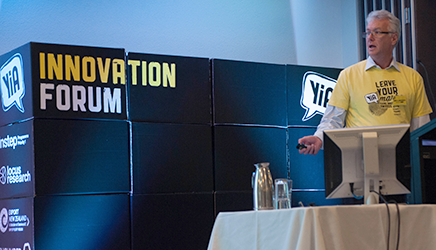
Next up was John Illingsworth, a man with over 40 years of success stories, including roles in civil engineering, civil contracting, management and construction. But this story was from one of his latest ventures - OceanNZ Blue, New Zealand's largest paua farm.
OceaNZ Blue is a land based aquaculture company, producing over 6 million paua a year. Seen as a status food, a huge section of their market is based over in China, which has meant many learning curves and innovative developments for the company.
The first innovation was brought about because of quality control, ensuring the farm water was up to scratch - water quality is key in this business. Originally, OceaNZ didn't have the best filtration system for the job. After much research into different systems, John found the expense wasn't worth it, and being an engineer at heart, set out to develop his own. Keeping on track with the mindset that 'imagination is greater than knowledge', some clever team work, and of course the internet, John developed a seawater recirculation system custom fit to his farm. This new system was capable of recirculating up to 1200 litres per second, allowing the company to grow huge numbers of paua, with lower risk of issues such as algae bloom.
The next lesson he learnt was to keep up with demand. John stressed the importance of not under-estimating the Asian production capability - they can do most things faster, better and cheaper then we can in New Zealand, so it's vital you understand your competitive advantage. You need to outrun the people you are competing with and take to market quickly. Bias to action is not a license to fail. You need to act to learn.
It's also essential to know your market, understand the cultural differences and sales traditions in countries outside of New Zealand. OceaNZ Blue went through a steep learning curve trying to convince the Asian market of their quality product - which included striking out their own brand and allowing China to market the OceaNZ product in ways that resonate with the Asian market. After all, 'you can't just sell the sausage, you have to sell the sizzle'.
Last but certainly not least, there was a concurrent theme of learning from your mistakes. When innovating and developing, it's important to foster a culture where everyone can speak up, learn from and have the ability correct each other. In turn, this will lead to healthy, innovative and enthusiastic work environment.
Takeaway Points
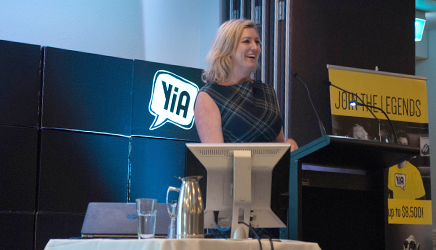
The entrepreneurial spirit sparked early for Jenene, who left school to work on her first web-based business: nzgirl.co.nz. This was 1999; before Facebook, Pinterest or iPhones; the term 'blog' had only recently be coined. Starting off by putting in the hard yards and manual labor in the pre-digital age is probably the reason the site is still alive 15 years later. But she didn't stop there. Jenene has also founded beauty appointment site Flossie.com and recently launched Flossy Concierge, as well as bloggersclub.com blogging agency.
She didn't get where she is by tracking along with the idea that started it all either - with the mantra 'Innovate or Die' driving her from success to success. In fact, she shared a tattoo on her wrist that says, "more," cementing her drive to keep innovating and not be satisfied with resting on her laurels. She did acknowledge, however, that success doesn't happen in a straight line. The line is very curved, messy, and sometimes goes backwards, which is ok. But she insists that she will never, never, never give up.
Jenene has also found people to be a key to innovation - collaboration and a love for the customer experience. Focusing on the brand, from the look and feel to the interactions that clients have with your company, is everything. Nowhere is this stronger than her Flossie.com website, which caters specifically to women. Keeping it "unapologetically female" cements not only the customer base and salons they go to, but adds to a feeling of exclusivity and polish that keeps customers coming back and drives the brand home.
Takeaway Points
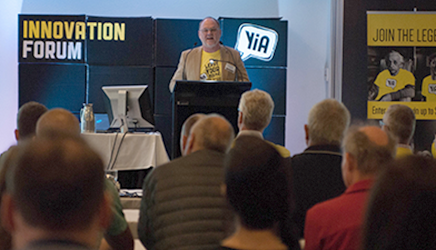
The only fair way to describe Professor Simon Fraser's design pedigree is 'world class'. More than 20 years in the rarefied air of the Porsche Design studio in Austria leaves no doubt as to his credentials - irreproachable. However, his journey to these lofty heights began right here in New Zealand, with a Bachelors of Industrial Design at the University of Auckland and some summer work at a contract plastics manufacturer.
Moving through the ranks at Fisher & Paykel, he worked on homeware designs and some of their first healthcare products, including a respiratory humidifier system that entered F&P into the respiratory market.
Four years at Fisher & Paykel prepared him for Porsche Design studio in Austria, where Simon spent 20 years developing products in a huge range of categories, from furniture, watches, and sunglasses to home appliances and electronics, and of course, vehicles. One of these, a seamless and streamlined bicycle design, utilised a material that hadn't been used in the category before - a honeycomb and fibreglass paneling. By going beyond what is ready available and speculate what is not available yet. Sometimes it is about setting aspirational goalposts and by doing so committing to something long term.
Another design stressed the importance of cultural and social considerations in technology development. A headphone design for Yamaha was inspired by a rolled up measuring tape, and took visual cues from the booming sportsware industry of the 80's. They took the form beyond the purely practical and designed a product that went beyond the typical shape and function available at the time. A fashion accessory, rather than just a set of ear-speakers. This was illustrated by the ad campaign, which shows the headphones being 'worn' in ways that don't resemble their intended purpose - as a bowtie or eye patch for example.
After 20 years, and Simon came to the realisation that when you've designed everything, including the kitchen sink, you know it's time for a change. He was enticed back to New Zealand, to Victoria University of Design, Wellington. In 2001 Simon was appointed founding Programme Director of Industrial Design. He took over as Head of School in December 2006 and was recently appointed Associate Dean (Research & Innovation) for the Faculty of Architecture and Design. He has led students through internationally renowned projects, such as the fun, pet-like Pinokio lamp that follows movement, and the Cortex 3D printed exoskeleton cast that won a James Dyson Award.
Ever the active innovator, Simon's current activities focus on integrating design research into the commercialisation of new technologies, with a focus on additive manufacturing, via the NZ Product Accelerator. He is also an Associate Director in the new MedTech CoRE responsible for the Design and Manufacturing Technology Platform.
Takeaway Points
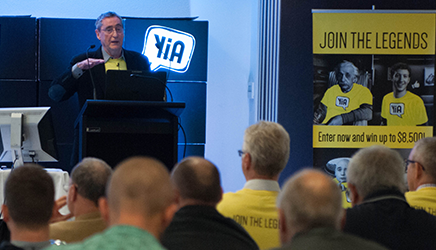
Last, but certainly not least, is Barry Vercoe; a man with an impressive resume. He is a co-founder and Professor emeritus of MIT Media Lab. He also co-founded One Laptop Per Child and provided a guiding hand in the development of Echo Nest, as well as countless other unmentioned success.
Let's start with the launch of MIT Media Lab, in 1985. The MIT Media Lab is an interdisciplinary research laboratory based in the US, devoted to projects in the realms of technology, multimedia, sciences, art and design. Students (a well as staff), use the purposefully built space to learn, create, discover and of course innovate. Barry commented that problem solving and innovation are very different things - so they encouraged students to cross-collaborate no matter their background, to ensure they are generating meaningful outcomes.
He believes that a selective entry process aided in this - "always look for the crazy ones, they have great ideas and aren't afraid to explore them". The staff even asked the current students their thoughts on applicants, in order to create the most beneficial environment for all. He believes that a clash of cultures, disciplines and ways of thinking, paired with a high tolerance for failure is the best recipe for innovation.
Alongside MIT, Barry's next major endeavor was One Laptop Per Child (OLPC), founded in 2005 and continues on to this day. OLPC aims to give free and open source software to children, to allow them to learn through design, construction, expression and collaboration.
After a bit of experimentation, Barry developed a Mechano style laptop that children have to build before they can use it. These laptops have been trialed and tested and currently have a home in a Maori school in the Coromandel. The project sparked many questions for Barry. What should education be, when information is just a few clicks away? Is computational learning the new literacy? What can computers and children learn from each other?
This final question led to an interesting journey around audio matching for music identification and eventually into the birth of Echo Nest in 2006 - which quickly became the leading Music Intelligence Company in the world. Essentially, Echo Nest translates music data to understand music trends. This can then be translated into recommendations, playlists and predictions in the music realms. Customers of Echo Nest include MTV, Vevo and Spotify - a huge testament to the technology.
After a rapid development and expansion, the Echo Nest team were offered huge money to hand over their technology, including an offer from Apple. A battle commenced, but Spotify came out on top, with an incredible offer they couldn't refuse. Spotify now uses the Echo Nest technology as its Music Intelligence Engine.
This summary doesn't even scratch the surface of Barry's accomplishments. His innovation stories were captivating, honest and eye opening and made for a fantastic close to the Innovation Forum 2015.
Takeaway Points
This event is brought to you by the Young Innovator Awards, and is supported by Priority One's Instep Programme, Locus Research, Cucumber, ExportNZ & Woods - the Creative Agency.
Comments
Post new comment